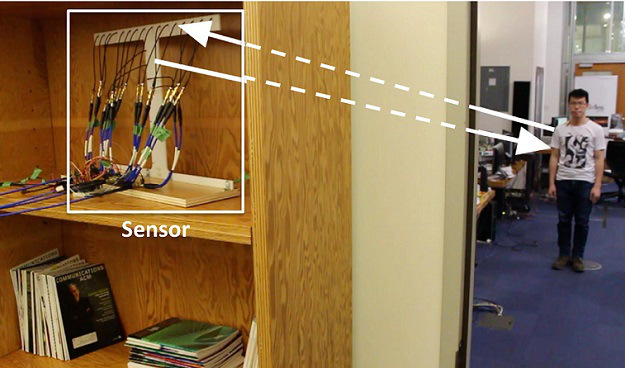This is some seriously cool stuff. Researchers at MIT recently came up with a device that can “see” through walls. It can actually identify a person (or people) behind a solid object.
They call it RF-Capture and it uses radio waves to identify people. Kind of like some high tech radio-frequency sonar. Using a very complex algorithm it can reconstruct the human figure by analyzing the various reflections of the signals transmitted. It’s so accurate it can even distinguish between different people based on size and posture, and even trace a person’s handwriting in the air.
Sounds like whatever they’re doing, it’s probably blasting a lot of radiation to do it. You’d think so, but no.
The transmitted power is actually 10,000 times lower than a cellphone. Crazy!
While it might not be quite the same caliber as this research, did you know you can make a rudimentary sonar device using microphones and piezo elements?
[via BGR]

















WiSee https://www.youtube.com/watch?v=VZ7Nz942yAY
That is just creepy for some reason.
:O it can track handwriting, brilliant.
I’m going to say “air writing”, I’d be surprised if it was even accurate enough to pick up sign language.
Oh the Kinect has been doing this for years, MS just never got around to telling us that also “sees” through walls, and has identified everyone in your household, their habits, and activity levels and reported back to Redmond…
B^)
“Kind of like some high tech radio-frequency sonar”
At some point, someone’s going to come up with an acronym for this.
I got one. Radar. Oh wait.
:p
Why aren’t the legs seen? Arms are, and they are less massive, less muscular, less bones …. Feets are also. But not the legs. Anyone has an explication?
Probably because the pants (jeans) disperse or absorb the radio waves so much that there is not much of a reflection to be seen.
New product Idea, RF scattering stealth T-Shirts, you can sell them next to the metal wallets.
The future is grim…
http://i.imgur.com/iKljahq.jpg
They are filtering based on range. What you are seeing is a snapshot/slice at a certain distance. The legs are further away than feet and upper body.
Actually neither is correct, from the paper:
“It is difficult for RF-Capture to capture reflections from the user’s
legs. This is because even as the legs move, they deflect the incident
RF signals away from the antenna array (toward the ground) rather
than reflecting them back to the array since the normal to the surface
of the legs stays almost parallel to the ground. (Note that placing
the antenna array on the ground instead would enable it to capture a
user’s legs but would make it more difficult for the array to capture
his head and chest reflections.)”
“Human”..LOL..
The good people at one of our national labs can probably say…
Been there (19 years ago), done that (well, not exactly the same but still w/radio waves):
https://str.llnl.gov/str/pdfs/01_96.2.pdf
And if you want to go out and get some tech for your self, I think (some of) Zircon Stud Finders use some similar ideas.
As for the above effort, by the looks of it, it’s a phased array. So I assume X-direction is controlled by sweeping the beam. And the Y-direction, as Falense points out, is timed. Probably why the array is placed higher then the person. I suspect if you want more resolution you do the things that side-scan-sonar and side-scan-radar people do. Tighter beams and more precise timing.
Its beamforming nothing more
What’s your point?
Meanwhile more than 2 years ago this idea was already a product. https://vimeo.com/57781065
Complaints aside this could be neat in a home. With a ring to press to activate gesture actions. Combine it with position detection (or one time manual positioning) of in home devices and we could turn things like a TV, heater, fan etc on/off by pointing at them.
My backyard neighbors are watching me in my house. Is it possible they could be using this to follow me inside and outside my home? I feel like I am being tracked by an ankle bracelet like some criminals have to wear, but I have not put any device on my body, car and home. Any help would be greatly appreciated!